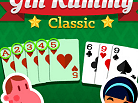GAME OBJECTIVES
Test your Gin Rummy skills in this fun version of the popular two-player card game! Choose between different opponents, each with a different playing style, select one who matches your skill level and try to earn the most points. Sort your cards to form sets and runs, keep an eye on your opponent and use the right strategy to win! Are you able to get a Gin?
If you don't know how to play the game, u better read below:
Cards
Gin is played with a standard 52-card pack of cards. The ranking from high to low is King, Queen, Jack, 10, 9, 8, 7, 6, 5, 4, 3, 2, Ace (kings over aces).
Objective
The objective in gin rummy is to score points and reach an agreed number of points or more, usually 100, before the opponent does.
The basic game strategy is to improve one's hand by forming melds and eliminating deadwood. Gin has two types of meld: Sets of 3 or 4 cards sharing the same rank, e.g. 8♥ 8♦ 8♠; and runs of 3 or more cards in sequence, of the same suit. e.g. 3♥ 4♥ 5♥ or more. Deadwood cards are those not in any meld. Aces are considered low—they can form a set with other aces but only the low end of runs (A♠ 2♠ 3♠ is a legal run but Q♠ K♠ A♠ is not). A player can form any combination of melds within their hand, whether it contains all sets, all runs, or a mix of both. A hand can contain three or fewer melds to knock or form legal gin.
The deadwood count is the sum of the point values of the deadwood cards—aces are scored at 1 point, face cards at 10, and others according to their numerical values. Intersecting melds are not allowed; if a player has a 3-card set and a 3-card run sharing a common card, only one of the melds counts, and the other two cards count as deadwood.
Dealing
Dealership alternates from round to round, with the first dealer chosen by any agreed upon method. The dealer deals 10 cards to both players, and then places the next card in the deck face up. This begins the discard pile. The face down pile is known as the stock pile. On the first turn of the round, the non-dealing player has first option of taking the upcard on the discard pile or passing. If the non-dealing player takes the upcard, the player acting second can take the top card from the pile of his or her choice. However, if the non-dealing player passes the upcard, the dealer is given the opportunity to take the upcard or pass. If the dealer also passes, the non-dealing player must draw from the stock pile, then the next turn and after, players can draw from the pile of his or her choice.
Gameplay
On each turn, a player must draw either the (face-up) top card of the discard pile, or the (face-down) top card from the stock pile, and discard one card from his or her hand onto the discard pile.
Players alternate taking turns until one player ends the round by knocking, going Gin, or until only two cards remain in the stock pile, in which case the round ends in a draw and no points are awarded. The game ends when a player reaches 100 or more points (or another established amount). In tournament rules the game is played in best of five with 250 points per game.
Knocking
In standard gin, only a player with 10 or fewer points of deadwood may knock. Knocking with 0 points of deadwood is known as going Gin or having a Gin hand, while knocking with deadwood points is known as going down.
To knock, the knocking player discards as usual, announces knocking (generally by simply placing a discard face down), and the hand is laid out with the melds clearly indicated and deadwood separated. The other ("defending") player is then entitled to lay out any melds in his or her hand and can then lay off any of his or her remaining deadwood cards that fit into the knocking player's melds, provided that the knocking player does not have a gin hand.
For example, the knocking player has a meld of three Kings. The defending player's deadwood has a king. The player can lay off that king, reducing the deadwood count by ten. The knocking player can never lay off his or her deadwood into the defending player's melds. Once a player knocks or declares gin the round is over and scores are tallied, players cannot draw.
The knocking player then subtracts his or her deadwood points from the defending player's deadwood points. The result is the number of points the knocking player receives. An undercut occurs if a player knocks and the defending player's deadwood points are less than or equal to the knocking player's. In this case the defending player receives an undercut bonus (usually 25 points) plus the difference in deadwood points. If the defending player has less or equal deadwood to the knocking player's deadwood after laying off any of his or her deadwood, then it is still a valid undercut.
Gin
If all 10 or 11 cards in a player's hand fit into melds and thereby the player has no deadwood, he or she can choose to go Gin in which case the round ends and the player going Gin receives a Gin bonus of 25 points (or another established amount) plus any deadwood points in the opponent's hand. The defending opponent can only lay out his or her melds and cannot lay off any deadwood into the melds of an opponent that has declared Gin. A player can go Gin with a hand of three or fewer melds as long as all cards fit into a meld.
Done with this? Play more card games here.
It's an HTML5 game!

Updated:
April 27, 2017 4:43 PM
 |
MY GAME
|
GAME INSTRUCTIONS
Right-click game to play full-screen (if available)
Mouse or finger tap.
Scoring
Aces are scored at 1 point, face cards at 10, and all other cards are scored at their numerical values. The number of points awarded for bonuses may vary from region to region. No matter what the bonus amounts are, points are scored in Gin for the following:
- Knock Points
- After a player knocks, and the lay offs are made, the knocking player receives a score equal to the difference between the two hands. For example, if a player knocks with 8, and the defender has 10 deadwood points in his or her hand after laying off, the knocking player receives 2 points for the hand.
- Gin Bonus
- After going gin, a player receives a bonus of 25 points plus the entire count of deadwood in the opponent's hand. There is no chance to lay off when a player goes gin.
- Undercut (or underknocking)
- Occurs when the defending player has a deadwood count lower than or equal to that of the knocking player (this can occur either naturally or by laying off after a knock). In this case, the defender scores an undercut bonus of 25 points plus the difference between the two hands. (In some rule sets, the bonus is only 10 or 20 points, or is not awarded in case of a tie.)
- Game Bonus
- Once a player has acquired 100 points (or some other agreed-upon number) the game is over, and that player receives a game bonus of 100 points (or another agreed-upon number).
- Line Bonus or Box Bonus
- Added at the end of the game. For every hand a player won during the game, 25 points is added to his or her score.
- Big Gin
- Prior to knocking, if all 11 cards in a player's hand form a legal gin, the player can retain the extra card as part of his or her hand, and is awarded 31 points plus entire count of deadwood in his or her opponent's hand. (In some rule sets players may be awarded 50 points or another established amount plus the entire count of deadwood in the opponent's hand)
- Shutout Bonus
- If a game is completed with the winner having won every hand, the points for each hand are doubled before adding the line bonus.

CLICK HERE TO PLAY FULL SCREEN!

|